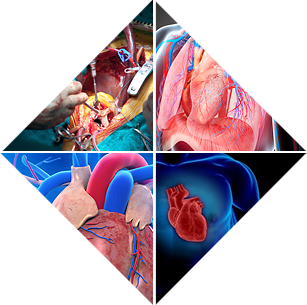
Cardiac-Surgery-CABG
Asia Med Care has collaborated with several hospitals in India for the best possible cardiac treatment with a team of highly trained and experienced cardiologists and Cardio-thoracic surgeons to ensure world class treatment, providing a rejuvenating and healing experience improving the lives of cardiac patients.
BG (Coronary Artery Bypass Graft Surgery)
Arteries carry blood from the heart to the rest of the body,
and coronary arteries supply blood to the heart muscles. When
the coronary artery gets blocked, a new channel is created to
bypass the blockage, which is called bypass graft surgery.
Coronary artery bypass graft (CABG) surgery reestablishes
sufficient blood flow to deliver oxygen and nutrients to the
heart muscle. The bypass graft for a CABG can be a vein from
the leg or an inner chest wall artery. The length of the
surgery varies with each patient. However, it generally takes
4-6 hours from the time you enter the operating room.
The Surgery:
The cardiac surgeon makes an incision down the middle of the
chest and then saws through the breastbone (sternum). This
procedure is called a median (middle) sternotomy (cutting of
the sternum). The heart is cooled with iced salt water, while
a preservative solution is injected into the heart arteries.
This process minimizes damage caused by reduced blood flow
during surgery and is referred to as "cardioplegia." Before
bypass surgery can take place, a cardiopulmonary bypass must
be established. Plastic tubes are placed in the right atrium
to channel venous blood out of the body for passage through a
plastic sheeting (membrane oxygenator) in the heart lung
machine. The oxygenated blood is then returned to the body.
The main aorta is clamped off (cross clamped) during CABG
surgery to maintain a bloodless field and to allow bypasses to
be connected to the aorta.
Precaution:
It is important to walk every day. Begin walking for 5 minutes about 3-5 times a day, and gradually increase the distance so you're walking for 20 minutes.
- Do not lift anything heavy.
- Do not drive, until the surgeon advises (usually in 4-6 weeks).
- Do not engage in forceful movements.
Risk and Complications:
Overall mortality related to CABG is 3-4%. During and shortly
after CABG surgery, heart attacks occur in 5 to 10% of
patients and are the main cause of death. About 5% of patients
require exploration because of bleeding. This second surgery
increases the risk of chest infection and lung complications.
Stroke occurs in 1-2%, primarily in elderly patients.
Mortality and complications increase with:
- age (older than 70 years),
- poor heart muscle function,
- disease obstructing the left main coronary artery,
- diabetes,
- chronic lung disease, and
- chronic kidney failure.

